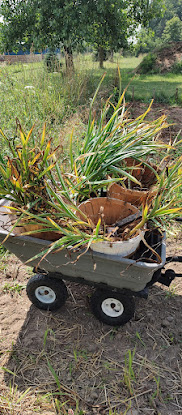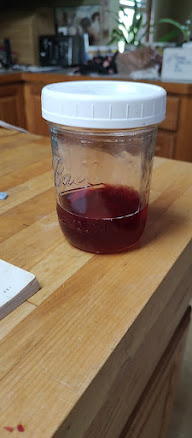Last summer, once we'd finished building and laying mats in the remaining stalls in the barn, DH decided it was time to start another big project. Not quite as big as building stalls in all the many facets that entailed, but still, a multi-part project that required quite a bit of use of heavy equipment. This multi-part project was a pre-req of another project we'd been talking about off and on for about a decade. Ironically, the pre-req wasn't easier than the other project, unlike when you are taking classes and there's a pre-req.
So, what was this particular project? Digging out and replacing the culvert that runs under our driveway up near the house/garage. Put in back in 2002, when the driveway to our house was 'built', we'd since discovered two things:
- The driveway curve to approach the house/garage from the north wasn't quite where we had originally wanted it to be. The stake we'd put in to mark the middle of the driveway for the curve was mistaken as the eastern-most edge of the curve. And once the driveway was installed, and the house/garage built, approaching the garage straight enough to pull in the overhead door was a bit tricky on the eastern-most door.
- In order to 'fix' the driveway and re-route that curve to the more desirable location/arc for straight approach to that particular door, we would need to extend the culvert. And bring in more dirt/base material to build up the location for that curve.
Neither was a real hot button, and over the years there were much more pressing things to spend our time and money on. But, while building DH's shop in the Fall of 2022, the culvert got damaged. Being driven over repeatedly by a 25-yard gravel train (of sand needed in bringing up the grade around one half of the shop) had crushed part of it.
Didn't affect us much until winter came, and it was a really wet winter. Lots and lots of rain, often on top of frozen ground. Water pooled up in the circle part of our driveway because the culvert was partially blocked. And then when things started to thaw out, that crushed culvert became an extremely leaky culvert, and a small sinkhole developed in the driveway. Now it was a problem.
Hence, DH's decision to not extend the culvert, but to replace it. And if we were going to replace it, we might as well get one long enough to be what we'd need when re-doing that curve in the driveway. (And if we were going to have the right length culvert, we might as well put the driveway reroute on our calendar. . .)
So, we walked off several driveway culvert location scenarios, complete with rope to lay down as a visual so we could see which option we liked best. The one we both agreed was the most preferable in terms of drainage and working with where we wanted to amend that curve in the driveway was in the same spot as the crushed one, but about twice as long so that it both extended further into the circle part of the drive for better reach to the lowest part of the circle and ran under and out the other side of the grassy slope we used as a way to back long trailers perpendicular to the front door of the barn and pull out straight up onto the driveway where it goes past the house. Which is how we ended up needing 30+ feet of culvert.
That is not an easy size to come by when you are doing this yourself and want a normal diameter corrugated plastic driveway culvert instead of some massive takes-a-creek-under-a-roadway diameter metal culvert. Thankfully, the nearby big box store had 10' (or was it 12'? I don't remember now) sections in stock as well as the needed couplers to connect it all to the desired length.
Before the new culvert could be installed, the old one had to be removed. DH did a little digging with the tractor bucket, and a little digging by hand, and had me wrap a strap around the middle of the existing culvert via the hole he'd dug above and on either side of it. His thought was with the strap around the middle then attached to the tractor bucket, he could use the tractor to lift up and pull out the old culvert.
What he didn't account for was how much dirt had washed in via the broken spot (remember the sinkhole in the spring?) That dirt was heavy, and the tractor could not pull the culvert free of it's spot in the driveway even with most of the layer of driveway removed from above it. Which meant more hand digging. Another attempt at pulling with the tractor broke the culvert into two pieces, the lighter of which came out. More digging (and sweating, and, truthfully, swearing) and eventually the entire old culvert was out. Which left a trench about a foot and a half wide across the width of the driveway. And, now it was getting too late at night to put the new one in because the removal had taken about four hours longer than anticipated.
(Seems like every project--and some vacations--we endeavor to do there's always a lengthy frustrating delay or unforeseen problem that becomes kind of a funny memory years in the future. Maybe someday I'll write the story of our trip from Michigan to Oregon hauling a new-to-us camper in 2008 and blowing out 3 of the 4 camper tires one by one along the way. . . )
The next day, we dug out the trench for the new culvert to sit in, using the laser transit to mark depth so that there were no high spots along the length of it. Afterall, the whole idea of this new culvert was to get the water to drain where we wanted it to and not create puddles, sinkholes, or really muddy areas where we needed to drive which included not just the existing driveway but the area in front of the barn and the shop where we intended to create a driveway. Getting the pitch right was very important.
Once we had the trench at the right length, depth, and pitch, the new culvert pieces were joined together and laid into the trench. Easy peasy. Then DH backfilled, using the tractor.
We ordered some gravel, and spread that over the part of the driveway that we'd had to dig up for the culvert replacement. Good as new!
The slop (or 'ramp' as we typically refer to it) that now had a culvert underneath it needed a little modification in width and pitch, both to protect the culvert when being driven over as well as for ease of driving a vehicle towing a trailer or hay wagon up or down. Using dirt from a place in the field DH had been wanting to modify (for better drainage) anyway, he adjusted the ramp. The old culvert had ended about 6' from the ramp (which had been the north edge of the existing little hill we'd built the house at this little place here on), and that distance had made a really hazardous drop off of about three feet on the driveway edge. Now, with the new, longer culvert, we filled that in so that the driveway--with it's newly adjusted curve--and the ramp flow together. No drop off for unsuspecting visitors (or drivers not paying attention) to fall off of.
That was then end of this phase of our two part project. The second part happened during the winter.
































